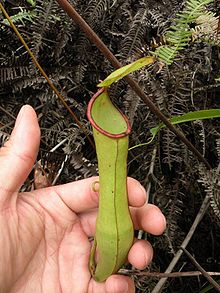沙禮花-哈薩豬籠草
沙禮花-哈薩豬籠草(學名:Nepenthes × sharifah-hapsahii)是由小豬籠草(N. gracilis)與奇異豬籠草(N. mirabilis)雜交得到的自然雜交種。[4][5][6]其存在於婆羅洲、蘇門答臘、西馬來西亞和泰國。[7][8][9][10][11][12]沙禮花-哈薩豬籠草最初被描述為西馬來西亞的特有種,並提到其生長於海拔1000米以下的地區。[1]
| 沙禮花-哈薩豬籠草 | |
|---|---|

| |
| 產自西馬來西亞彭亨的沙禮花-哈薩豬籠草的上位籠 | |
| 科學分類 | |
| 界: | 植物界 Plantae |
| 演化支: | 維管束植物 Tracheophyta |
| 演化支: | 被子植物 Angiosperms |
| 演化支: | 真雙子葉植物 Eudicots |
| 目: | 石竹目 Caryophyllales |
| 科: | 豬籠草科 Nepenthaceae |
| 屬: | 豬籠草屬 Nepenthes |
| 種: | 沙禮花-哈薩豬籠草 N. × sharifah-hapsahii
|
| 二名法 | |
| Nepenthes × sharifah-hapsahii | |
| 異名 | |
植物學史
編輯2001年8月2日,J·H·亞當在馬來西亞國民大學的校園內採集到了沙禮花-哈薩豬籠草的模式標本。其模式標本(JHA 8000)和等模標本都存放於馬來西亞國民大學的植物標本館中。[1]沙禮花-哈薩豬籠草即得名於馬來西亞國民大學的副校長,沙禮花·哈薩·賽義德·哈桑·沙哈布丁教授(Dr. Sharifah Hapsah Syed Hasan Shahabudin)。[1]
伽扎爾利豬籠草(Nepenthes × ghazallyana}})[13]為沙禮花-哈薩豬籠草的同物異名。其得名於伽扎爾利·伊斯梅爾(Ghazally Ismail)。[5]
形態特徵
編輯沙禮花-哈薩豬籠草的莖為圓柱形,無毛被,可攀爬至5米的高處。葉片革質,為披針形或長圓形,長9至20厘米。籠蔓可長達20厘米。捕蟲籠的下部和上部為漏斗形,中部為管狀。其可高達15厘米,寬至3.5厘米。唇為圓柱形,寬1至2毫米。唇齒和唇肋明顯。籠蓋為圓形,下表面覆蓋着蜜腺。花序為總狀花序,花序軸長30至35厘米。雌性花序未知。[1]
分類關係
編輯沙禮花-哈薩豬籠草與小豬籠草存在着密切的近緣關係。根據J·H·亞當和哈菲查·A·哈米德(Hafiza A. Hamid)的論述,下表為兩類群之間的區別。[1]
| 沙禮花-哈薩豬籠草與小豬籠草之間形態特徵的區別(Adam & Hafiza) | ||
| 形態特徵 | 沙禮花-哈薩豬籠草 | 小豬籠草 |
|---|---|---|
| 莖的形狀 | 圓柱形 | 三稜柱形或稜柱形 |
| 葉片基部 | 漸尖至葉柄,葉基不下延,但包住莖約周長的一半 | 不縮成葉柄,基部下延 |
| 籠蓋下表面的蜜腺 | 大量 | 少量 |
| 捕蟲籠內表面的消化腺 | 覆蓋型腺體:延伸的表皮覆蓋着一半以上的消化腺 | 暴露型腺體:覆蓋蜜腺的表皮不發達,幾乎所有的腺體都暴露在外 |
| 唇肋 | 明顯 | 不明顯 |
| 花梗 | 雄性花序下三分之二的花梗帶兩朵花,上三分之一的花梗帶一朵花 | 均只帶一朵花 |
J·H·亞當和哈菲查·A·哈米德也注意到沙禮花-哈薩豬籠草與東巴豬籠草(N. tobaica)類似。與東巴豬籠草相比,沙禮花-哈薩豬籠草捕蟲籠內表面具覆蓋型的腺體,雄性花序的上三分之一僅帶一朵花,且葉片上有許多的縱脈。[1]
參考文獻
編輯- ^ 1.0 1.1 1.2 1.3 1.4 1.5 1.6 Adam, J.H. & Hafiza A. Hamid 2007. Pitcher plants (Nepenthes) recorded from Universiti Kebangsaan Malaysia, Bangi, Selangor, Malaysia.[永久失效連結] International Journal of Botany 3(1): 71–77. doi:10.3923/ijb.2007.71.77
- ^ Adam, J.H., C.C. Wilcock & M.D. Swaine 1992. The ecology and distribution of Bornean Nepenthes. 互聯網檔案館的存檔,存檔日期2011-07-22. Journal of Tropical Forest Science 5(1): 13–25.
- ^ Macfarlane, J.M. 1908. Ordo CLXXV bis. Nepenthaceæ. In: A. Engler. Das Pflanzenreich IV, III, Heft 36: 1–91.
- ^ McPherson, S.R. 2009. Pitcher Plants of the Old World. 2 volumes. Redfern Natural History Productions, Poole.
- ^ 5.0 5.1 Schlauer, J. N.d. Nepenthes × sharifah-hapsahii (頁面存檔備份,存於互聯網檔案館). Carnivorous Plant Database.
- ^ Rice, B.A. 2006. Do you want to tell me about a species I missed? (頁面存檔備份,存於互聯網檔案館) The Carnivorous Plant FAQ.
- ^ Clarke, C.M. 1997. Nepenthes of Borneo. Natural History Publications (Borneo), Kota Kinabalu.
- ^ Clarke, C.M. 2001. Nepenthes of Sumatra and Peninsular Malaysia. Natural History Publications (Borneo), Kota Kinabalu.
- ^ (意大利文) Catalano, M. 2010. Nepenthes della Thailandia: Diario di viaggio. Prague.
- ^ McPherson, S.R. & A. Robinson 2012. Field Guide to the Pitcher Plants of Borneo. Redfern Natural History Productions, Poole.
- ^ McPherson, S.R. & A. Robinson 2012. Field Guide to the Pitcher Plants of Peninsular Malaysia and Indochina. Redfern Natural History Productions, Poole.
- ^ McPherson, S.R. & A. Robinson 2012. Field Guide to the Pitcher Plants of Sumatra and Java. Redfern Natural History Productions, Poole.
- ^ Adam, J.H. & C.C. Wilcock 1995. A new natural hybrid of pitcher plant from Sabah, Malaysian Borneo. Borneo Sci. 1: 1–7.
- Adam, J. H., R. Omar & C. C. Wilcock 2002. Phytochemical screening of flavonoids in three hybrids of Nepenthes (Nepenthaceae) and their putative parental species from Sarawak and Sabah.[永久失效連結] OnLine Journal of Biological Sciences 2(9): 623–625. doi:10.3923/jbs.2002.623.625
- Clarke, C.M. 2006. Introduction. In: Danser, B.H. The Nepenthaceae of the Netherlands Indies. Natural History Publications (Borneo), Kota Kinabalu. pp. 1–15.
- Damayanti, F., M. Mansur & I. Roostika 2011. Diversity of Nepenthes spp. in West Kalimantan. (頁面存檔備份,存於互聯網檔案館) International Journal of Biodiversity and Conservation 3(13): 705–708.
- (印尼文) Enjelina, W. 2012. Analisis hibrid alam kantung semar (Nepenthes) di Bukit Taratak Kabupaten Pesisir Selatan Sumatera Barat dengan teknik RAPD. M.Sc. thesis, Andalas University, Padang.
- (印尼文) Mansur, M. 2007. Keanekaragaman jenis Nepenthes (kantong semar) dataran rendah di Kalimantan Tengah. [Diversity of lowland Nepenthes (kantong semar) in Central Kalimantan.] Berita Biologi 8(5): 335–341. Abstract